A natural experiment created by an active volcano gives new insight into the long-term negative impacts of human colonisation of tropical forest islands. The findings are published in the British Ecological Society journal, Journal of Ecology.
Researchers from the University of Réunion island surveyed vegetation on more than 600 years of lava flows on the slopes of Piton de La Fournaise, one of the most active volcanoes in the world. Réunion island is part for the Mascarene archipelago which also includes Rodrigues and Mauritius, home of the extinct dodo.

Sébastien Albert, lead author of the study said “This series of lava flows delivers views of the vegetation development across several centuries, before and after the arrival of humans. They serve as a time-machine to look into the past.”
The researchers found that before permanent human settlements, forests were dominated by large fleshy-fruited plant species, usually big trees. During and after human settlement in the 17th Century, when fruit eating animals (frugivores) like giant tortoises and flying foxes went extinct on the island, these plants were found to be far less present and by 1800 they were nearly gone.
[ad_336]
Large frugivores play an important role in tropical forests because they swallow large fruits and deposit the seeds far away from the parent trees. Processes such as seed dispersal by animals are key for ecosystem recovery after a major disturbance like a lava flow, so when fruit eating animals are lost, tropical forests cannot fully recover.
“The global decline of large vertebrate populations is likely to have dramatic consequences on the regeneration of tropical forests worldwide.” said Sébastien. “The conservation of plant-animal mutualistic interactions is imperative. Our results strongly support rewilding projects to restore native frugivores in places like Réunion where they’re no longer found.”
The Mascarene archipelago were some of the last tropical islands colonised by humans. In 1665 when permanent settlement began, Réunion Island had giant tortoises, parrots, pigeons, skinks, flying-foxes, hoopoes, bulbuls and other songbird species, all living in forests that covered the entire island.
Within 80 years of colonisation, populations of large frugivore species had collapsed; within 150 years they were extinct. The largest remaining native frugivore is the Réunion bulbul, a bird that’s nine times smaller than the flying-fox and 1000 smaller than the giant tortoise.

This novel study was possible because of the high volcanic activity of Piton de La Fournaise creating frequent lava flows and the well documented animal loss in the Mascarene archipelago. By analysing historical data and updating it with modern information like GPS coordinates, the researchers selected 151 vegetation surveys where they could identify the age of the substrate the vegetation was growing on.
Substrate age was grouped into five categories: 1401 to 1665, when frugivores were abundant and diverse before permanent human settlement; 1665 to 1800, when large frugivore populations were drastically reduced; 1800 to 1900, when large frugivores went extinct but small frugivores were still abundant; and 1900 to 1956, when even small frugivore populations had declined.
[rand_post]
Although the decline in large fleshy-fruited plant species is mostly shaped by the loss of large frugivores, the researchers warn that there are other potential factors at play like seed predation from invasive species or environmental selection against this form of seed dispersal. “These factors are supposed to play a secondary role in our study that is demonstrated by ongoing field experiment on Réunion.” said Sébastien.
The researchers are now looking to focus more on the processes behind plant dispersal on the island.
“We are currently monitoring seed dispersal, conducting sowing experiments and regeneration surveys to monitor survival and growth of candidate plant species in which early stages are naturally lacking at large scale in the island forests.” said Sébastien. “These studies will provide accurate insights on the level at which those processes function nowadays.”